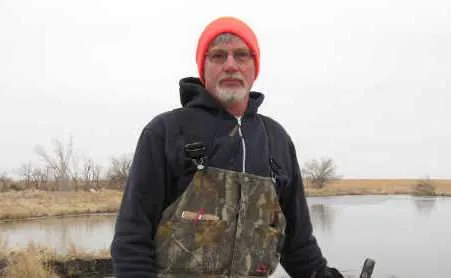I’m really telling my age here, but I can remember walking up the road with my dad to a couple ponds near our place when I was just a pup. We had a couple cane poles, each with a hook, sinker and bobber and a can of nightcrawlers for bait. We would sit there on the bank and catch largemouth bass and bullheads, usually taking home a bass or two for mom to fry. Next came a cheap fiberglass rod with a Johnson reel when I was in grade school.
The neighbor kids and I would load up our bikes with rods & reels and worms for bait and pedal to an old mill on the river a couple miles away where we’d fish in the calm back-waters near the old mill building, rarely even getting bites, let alone catching fish. If I happened to get to visit my grandparents in the nearby town, I’d get leftover dough from the bakery downtown, then walk to the park and fish with doughballs in a weed-infested pond there. Then, in junior high, my other grandpa would take my cousin and I to Michigan each summer, towing his wooden boat and motor behind his pickup and camper. We would fish for Rock bass, using nightcrawlers for bait. Not many fish were caught on any of these early fishing excursions, which relied on our knowledge and skills to put fish in the skillet.
Fast forward to a trip to Lake Fork, Texas ten years ago to visit friends. They took us fishing late in the afternoon, setting “waypoints” with the GPS feature on their high-dollar trolling rig as we dodged submerged stumps all the way across the lake. Later that night, well after dark, that GPS system guided us back to the dock, dodging all those same stumps in the pitch-black darkness, without our friend ever having to touch the boat steering wheel.
On an early-spring fishing trip last year to Kanapolis, another friend spent fifteen minutes (unsuccessfully) trying to teach me how to use his new sonar. On a monitor next to my seat, I could watch my jig descend to the bottom, and see it twitch and dance each time I “jigged” the rod tip up-and-down. I never really got the hang of using it, but I could see everything around us on the lake bottom, leaving me wondering “Just when is an advancement too advanced?”
Kansas Dept. of Wildlife and Parks (KDWP) Fisheries staff pondered the same question, “When is an advancement too advanced” as they considered the implications of the latest advancement in fish location technology called Live-Imaging Sonar, LIS for short. LIS is sonar that shows anglers fish and structure around and below their boat, usually with great clarity. LIS has fishermen choosing sides; some see it as a great addition, helping to guarantee a better fishing experience. Others see it as more of an ethical dilemma, blurring the lines of fair chase. KDWP sought to understand the impact of LIS on Kansas sportfishing, but no data was available to examine, so they decided to create their own study.
In early December, 2021, thirty-two fishermen, comprised of KDWP Fisheries and Wildlife employees, and people from Kansas State University, participated in a two-week experiment at Cedar Bluff Reservoir. Anglers were randomly partnered up and instructed to fish for winter crappie for seven hours on either the north or south side of the lake, and to fish either with or without the aid of LIS. The next day, they all switched sides of the lake and swapped use of the equipment. For data purposes, this resulted in sixteen controlled samples to examine. KDWP says the results were “unexpected.” I’m not sure what that means or what they expected to find, but here were the results:
• Anglers not using the new LIS sonar averaged 6.3 crappie per day, while anglers using the new LIS averaged 7.3 crappie per day.
• Adding into the study all other species of fish caught, fishermen not using LIS averaged catching 12.9 fish per day, compared to an average of 14.4 fish per day by anglers using LIS.
• Fishermen using the LIS caught crappie SLIGHTLY larger (less than one-half inch difference.)
More experienced fishermen and anglers already proficient in using Live-Imaging Sonar were not considered in this study, and the study concentrated on crappie, but overall, the data collected demonstrated that while the use of LSI by the casual weekend angler might SLIGHTLY improve the number and size of crappie caught, the difference was statistically minimal.
I’m certain LIS was what my friend tried to teach me to use at Kanapolis, and I’m also sure I have other friends who already have it on their boats or soon will have. Mind you, I’m not against technology and advancements in outdoor equipment, but let’s not allow them to water-down the reason we hunt and fish to begin with, and that is to continue to explore Kansas Outdoors.
Steve can be contacted by email at stevenrgilliland@gmail.com.





